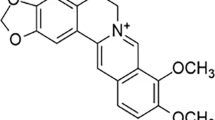Abstract
The purpose of the study was to investigate the mechanism of total flavone of Desmodium styracifolium (TFDS) in regulating the formation of urinary calculi. Protein levels of KIM-1, LC3-II, p-p38 were measured by Western blot. The effect of different COM concentrations, different TFDS concentrations, SB203580 (specific inhibitor of p38/MAPK), and overexpression of KIM-1 on cell viability were detected by WST-1 assay. The apoptotic cells and FITC positive cells were detected by flow cytometry. HK-2 cell viability decreased with the increase of COM concentration, and the protein levels of KIM-1, LC3-II, and p-p38 increased with the time. Blocking the p38/MAPK pathway or co-cultured with TFDS inhibited the effects of COM on apoptosis and autophagy of HK-2 cells. In addition, blocking the p38/MAPK pathway inhibited the expression of KIM-1. In COM-induced cells, after treated with SB203580, overexpression of KIM-1 could reverse the protection effect of SB203580 on COM-induced cell damage and the inhibition of SB203580 on COM-induced excessive autophagy, suggesting p38/MAPK regulated KIM-1 to regulate COM-induced cell apoptosis and autophagy. Finally, we proved that TFDS inhibited p38/MAPK pathway. And the protection effect of COM-induced cell injury increased with the increase of TFDS concentration, and the adhesion between COM and cells decreased with the increase of TFDS concentration. With the increase of the concentration of TFDS, p38/MAPK pathway was gradually inhibited, and KIM-1 and autophagy related proteins were decreased. TFDS inhibited HK-2 cell apoptosis and autophagy by regulating KIM-1 via p38/MAPK pathway.




Similar content being viewed by others
References
Chung SD, Liu SP, Lin HC (2013) A population-based study on the association between urinary calculi and kidney cancer. CUAJ-Can Urol Assoc 7:E716–E721. doi:10.5489/cuaj.366
Gan QZ, Sun XY, Bhadja P, Yao XQ, Ouyang JM (2016) Reinjury risk of nano-calcium oxalate monohydrate and calcium oxalate dihydrate crystals on injured renal epithelial cells: aggravation of crystal adhesion and aggregation. Int J Nanomed 11:2839–2854. doi:10.2147/IJN.S104505
Mittal A, Tandon S, Singla SK, Tandon C (2016) In vitro inhibition of calcium oxalate crystallization and crystal adherence to renal tubular epithelial cells by Terminalia arjuna. Urolithiasis 44:287
Liu L, Chen M, Chen X (2015) Analysis of alcohol dehydrogenase inhibitors from Desmodium styracifolium using centrifugal ultrafiltration coupled with HPLC-MS. J Serb Chem Soc 80:23
Wagner H, Bauer R, Melchart D, Xiao P-G, Staudinger A (2015) Herba Lysimachiae christiniae–Jinqiancao. Springer International Publishing, Cham
Xiang S, Zhou J, Li J, Wang Q, Zhang Q, Zhao Z, Zhang L, Chen Z, Wang S (2015) Antilithic effects of extracts from different polarity fractions of Desmodium styracifolium on experimentally induced urolithiasis in rats. Urolithiasis 43:433–439
Koul HK, Pal M, Koul S (2013) Role of p38 MAP kinase signal transduction in solid tumors. Genes Cancer 4:342–359. doi:10.1177/1947601913507951
Peerapen P, Thongboonkerd V (2013) p38 MAPK mediates calcium oxalate crystal-induced tight junction disruption in distal renal tubular epithelial cells. Sci Rep 3:1041. doi:10.1038/srep01041
Zhang Z, Cai CX (2016) Kidney injury molecule-1 (KIM-1) mediates renal epithelial cell repair via ERK MAPK signaling pathway. Mol Cell Biochem 416:109–116
Lim AI, Tang SC, Lai KN, Leung JC (2013) Kidney injury molecule-1: more than just an injury marker of tubular epithelial cells? J Cell Physiol 228:917
Ichimura T, Bonventre JV, Bailly V, Wei H, Hession CA, Cate RL, Sanicola M (1998) Kidney injury molecule-1 (KIM-1), a putative epithelial cell adhesion molecule containing a novel immunoglobulin domain, is up-regulated in renal cells after injury. J Biol Chem 273:4135–4142
Yu L, Gan X, Liu X, An R (2017) Calcium oxalate crystals induces tight junction disruption in distal renal tubular epithelial cells by activating ROS/Akt/p38 MAPK signaling pathway. Ren Fail 39:440–451. doi:10.1080/0886022X.2017.1305968
Rieger AM, Nelson KL, Konowalchuk JD, Barreda DR (2011) Modified annexin V/propidium iodide apoptosis assay for accurate assessment of cell death. J Vis Exp Jove 50:40
Sun XY, Gan QZ, Ouyang JM (2017) Size-dependent cellular uptake mechanism and cytotoxicity toward calcium oxalate on Vero cells. Sci Rep 7:41949
Edvardsson VO, Indridason OS, Haraldsson G, Kjartansson O, Palsson R (2013) Temporal trends in the incidence of kidney stone disease. Kidney Int 83:146
Ferraro PM, Curhan GC, D’Addessi A, Gambaro G (2016) Risk of recurrence of idiopathic calcium kidney stones: analysis of data from the literature. J Nephrol 30:1–7
Chongruksut W, Lojanapiwat B, Tawichasri C, Paichitvichean S, Euathrongchit J, Ayudhya VC, Patumanond J (2012) Predictors for kidney stones recurrence following extracorporeal shock wave lithotripsy (ESWL) or percutaneous nephrolithotomy (PCNL). J Med Assoc Thai 95:342–348
Ouyang JM, Yao XQ, Tan J, Wang FX (2011) Renal epithelial cell injury and its promoting role in formation of calcium oxalate monohydrate. J Biol Inorg Chem 16:405–416
Mi J, Duan J, Zhang J, Lu J, Wang H, Wang Z (2012) Evaluation of antiurolithic effect and the possible mechanisms of Desmodium styracifolium and Pyrrosiae petiolosa in rats. Urolithiasis 40:151–161
Rodgers AL, Webber D, Ramsout R, Gohel MD (2014) Herbal preparations affect the kinetic factors of calcium oxalate crystallization in synthetic urine: implications for kidney stone therapy. Urolithiasis 42:221–225
Zhao M, Duan JA, Che CT (2007) Isoflavanones and their O -glycosides from Desmodium styracifolium. Phytochemistry 68:1471–1479
Zhou C, Luo JG, Kong LY (2012) Quality evaluation of Desmodium styracifolium using high-performance liquid chromatography with photodiode array detection and electrospray ionisation tandem mass spectrometry. Phytochem Analysis 23:240–247
Acknowledgements
This project was supported by research grants awarded by the Traditional Chinese medicine and Western Medicine Research of Tianjin health and Family Planning Commission (2015134).
Author information
Authors and Affiliations
Corresponding authors
Ethics declarations
Conflict of interest
The authors have no actual or potential conflict of interest to declare.
Rights and permissions
About this article
Cite this article
Xie, H., Li, J., Gao, H. et al. Total flavone of Desmodium styracifolium relieved apoptosis and autophagy of COM-induced HK-2 cells by regulating KIM-1 via p38/MAPK pathway. Mol Cell Biochem 442, 169–175 (2018). https://doi.org/10.1007/s11010-017-3201-z
Received:
Accepted:
Published:
Issue Date:
DOI: https://doi.org/10.1007/s11010-017-3201-z




